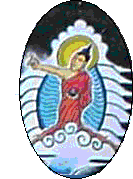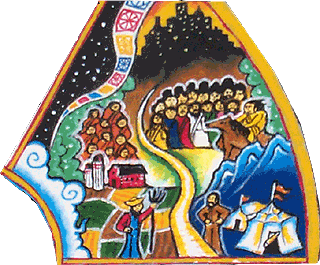Here is a detailed explanation on the 12 stages of the causes of existence :
Ignorance
The image is the figure of a blind man, groping along in the darkness. This is symbolic of our situation in the world, stumbling blindly from birth to death, ignorant of our true situation.
The ignorance of beings is a thick veil that obscures clear seeing of reality. It comes in two forms; dullness and confusion. The dull mind is weighted down by the darkness of unknowing into stupidity and torpor. The confused mind wanders in false passages, it is the mind shackled and burdened with false views.
Karmic Formations
The image here is of a potter, busy with her creations which she stores up for future use. Some of the pots are well-made and beautiful, others may be flawed and clumsy.
This is the symbol for our activity in the world, which is known as karma (Sanskrit) or kamma (Pali.) The word means "action," more specifically "effective action" or "work." This action arises from our ignorance. Because we do not understand things in their true nature, we are endlessly taking action in the world. Because of desire, which is rooted in ignorance, we seek always to modify the universe to our liking.
This modifying action inevitably creates an imbalance and the universe does not tolerate imbalance on any level. For every action, there inevitably follows an equal reaction. We reap what we sow.
All our experiences in the world are the results of karma which we have been accumulating since beginingless time. Beings can be compared to chaff on the wind, blown from birth to birth endlessly. But the wind is karma, and is of our own creation.
Conciousness
The image is of a monkey swinging from branch to branch. This is an excellent representation of consciousness, which jumps restlessly from object to object. The karma of our past deeds determines what object consciousness alights upon, just as the momentum of the monkey's leap determines the direction of his travel.
This process continues without pause, repeating itself moment after moment throughout each beings life. In the context of the dependent origination, it refers especially to the moment of birth, called rebirth-linking consciousness, when the past karma of the being drives it on to a fresh becoming in this or that order of beings.
The image of the monkey should not be taken too literally. There is in reality no thing which carries on from moment to moment, let alone from life to life. There is only conciousness arising again and again afresh to a kaleidescope of shifting objects. The continuity we perceive is an artifact of the inertia of karma, imposing patterns on experience.
Name and Form (or Body and Mind)
This picture is the image of three men in a boat. These represent the mental factors (the men) together with the physical factors (the boat.) This is body-and-mind or name-and-form. Buddhist psychology recognizes five aggregates, or bundles, which constitute a being; physical form, consciousness, perception, mental formations and feeling. These together constitute nama-rupa, lit. name-and-form.
The arising of consciousness to an object is always followed by the whole complex of psycho-physical factors which constitute a so-called personality. In an important sense, consiousness is the only active factor - it is that which goes towards its object.
In the arising of a new being in the womb, the rebirth-linking consiousness, conditioned by karma, in turn conditions the arising of the other mental factors together with the form of the physical base.
We separately name and describe these factors, but in reality they are inextricably mixed. Perception in particular is intimately bound up with consciousness; it is the process by which we create a universe each moment from incoming sense data.
The Six Sense Bases
The drawing of a house with six openings represents the sixfold sense base. These are the gateways through which the mind makes contact with objects. These are the senses of sight, hearing, taste, smell, touch and the mind sense. Each sense has its physical base and each its particular object.
This stage of the dependent arising represents the continued unfoldment of the body-and-mind and its outward going impulse.
It is significant that Buddhist philosophy always lists six senses; the mind-sense taking ideas as its object. This makes an interesting contemplation; to think of ideas as something we sense rather than something we do.
It should also be noted that the house is empty.
Contact
Contact is defined as the coming together of three factors; the organ of sense, the external object and consciousness. It is symbolized here by one of the most intense occurences of contact; a couple making love.
Contact is the process by which consciousess accesses the external world. Here we are peeking through the windows of the last image. Contact occurs again and again without cessation throughout a lifetime.
Remember that in Buddhist theory, there are six senses. The mind-sense is that which contacts objects of the mind (thoughts etc.) So even when there are no external sense impressions, contact is still occurring.
















